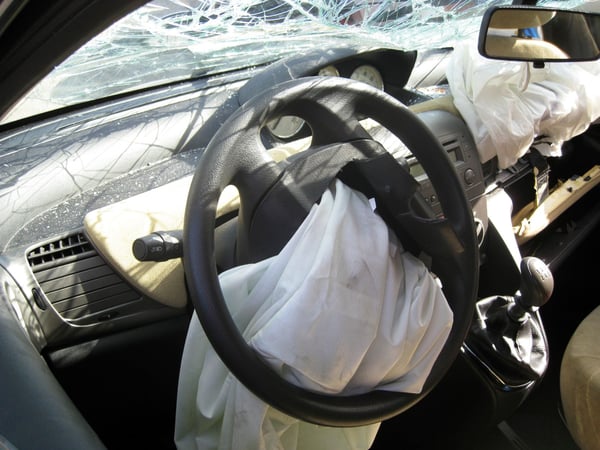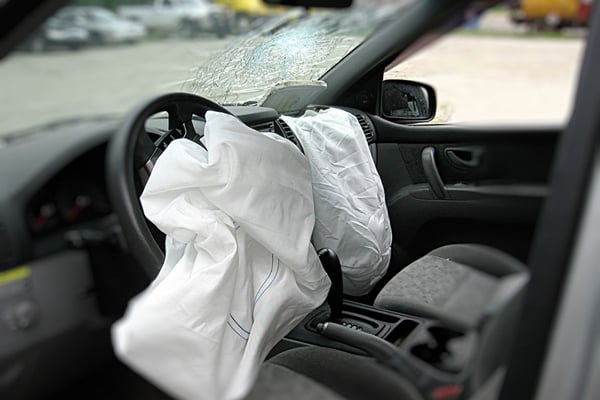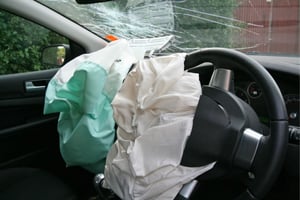Airbags are made to protect you in a car accident, and they do this very well.
However, the force with which the airbags deploy can injure you instead.
Even though other injuries from a car accident can cause chest pain, it is often a sign that the airbag has impacted your body.
This could be nothing but could also be a sign of a severe injury.
It is best to visit a car accident doctor to rule out anything life-threatening and start treating your injuries.
Aside from chest injuries, there are a few other types of injuries that can be caused by airbag deployment.
In the article below, we'll talk about the different kinds of injuries caused by airbags and how to treat them.
5 Key Takaways
-
Airbag Deployment Can Cause Injuries: While airbags are designed to protect in a car accident, the force with which they deploy can lead to injuries. Chest pain after an accident could be a sign of airbag impact.
-
Understanding How Airbags Work: Airbags are made of light fabric stored in various parts of the car. They deploy when a crash sensor detects a significant impact. The inflation and deflation process happens very quickly.
-
Safety Precautions: To minimize the risk of airbag-related injuries, it's important to maintain the correct distance from the steering wheel (recommended at 10 inches), wear seatbelts correctly, and ensure that children are properly restrained in the car.
-
Types of Chest Injuries: Airbag deployment can lead to chest injuries, ranging from contusions (bruising) to more severe conditions like broken ribs, collapsed lung (pneumothorax), or damage to internal organs.
-
Other Potential Injuries: Airbags can also cause injuries to the face, neck, back, and result in burns, both physical and chemical. Internal injuries can occur due to the chemicals released during airbag deployment.
Table Of Contents
- How Airbags Work
- Are Airbags Safe?
- Chest Injuries From Airbag Deployment
- Treatment And Recovery For Chest Injuries
- Other Accident Injuries Caused By Airbag Deployment
- How To Treat Airbag Injuries
- Contact The Arrowhead Clinic
How Airbags Work
Airbags are made from a light fabric stored in the car's paneling, the steering wheel, or the panel on the dashboard's passenger side.
When fully inflated, the driver's airbag is about the size of a large beach ball.
The passenger airbag is bigger because it deploys from farther away. Some cars also have airbags in the doors that will go off in a side-impact crash.
This includes the back seat.
A crash sensor tells the airbags to go off when a certain level of impact has been reached.
Most of the time, this happens when two cars crash head-on or almost head-on at over 10 miles per hour.
If the crash is bad enough, it will set off an igniter that will make a gas, like nitrogen or argon, fill the airbag.
The whole thing takes about 1/20th of a second. The airbag will deflate almost right away, which could send dust and chemicals into the air.
The crash sensor could go wrong, making an airbag go off when it shouldn't or not go off when it should.
If an airbag goes off even a fraction of a second too late, it could have dire consequences. Because of this, airbags are strictly regulated.
Seat belts and airbags can both hurt you because of how they are made, and these may sometimes interact.
Forcefully tightening a seatbelt may keep you from hitting an airbag, but it can also cause similar abdominal problems.
Keeping your seat at the proper distance from the steering wheel is imperative.
If this isn't done, the airbag might be too close or too far away to do its job and could cause more damage.
It is recommended that your seat is positioned 10 inches away from where the airbag would go off.
You can also avoid getting hurt by an airbag by wearing your seatbelt correctly and making sure that children are in the right place and using the proper restraints.

Are Airbags Safe?
In general, airbags are considered safe.
However, the National Institutes of Health have written several papers about the deaths airbags have caused. In these cases, there were many broken ribs, a lot of bruising inside the chest, and cuts and punctures to the heart and the membranes around it.
Most of these people were much shorter than average and were sitting less than 10 inches from the steering wheel.
This caused the airbag to hit the person's chest with all of its force when it went off. Sometimes, another injury made the driver slump forward, causing the same effect.
This is why kids under 12 should sit in the back seat, and a rear-facing infant seat should never be put where an airbag is active.
Chest Injuries From Airbag Deployment
Although it is not common, injuries to the chest might occur when the airbag applies pressure to that region.
Some chest injuries are minor or just surface-level, but you could suffer a severe chest injury.
A chest contusion is an injury that doesn't break the skin but injures the blood vessels or tissues under the skin. It can be caused by an external blow or force.
This can sometimes lead to a bruise but can also cause internal injuries requiring immediate medical attention.
Injuries commonly related to a chest contusion include:
- Myocardial contusion: A bruise on the heart can hurt the nerves and muscle tissue around it. This would make it harder for the heart to contract and pump blood around the body. If the case was bad enough, the person could die right away.
- Pulmonary contusion: This affects the lungs and can be especially dangerous because the person hurt might not immediately know something is wrong. In the meantime, blood and fluid can build up in the lungs, making it harder for the blood to get enough oxygen. Again, it could kill you if you don't get the right care for a bruised lung.
- Broken ribs: If you hit your chest hard enough, you could break one or more ribs. This is like breaking any other bone, except you can't put a cast on them. Broken ribs can get better over a period of months. A common problem is pneumonia, but the real danger comes when a fractured rib punctures an organ, especially the lung, causing bleeding and other issues.
- Pneumothorax: This is another name for a collapsed lung, which happens when air or fluid gets into the space between the lung and the chest cavity. This air or fluid puts pressure on the outside of the lung, making it collapse.
- Hemothorax: Hemothorax is when blood pools between the chest wall and the lung, usually because of a blow to the chest or a broken rib. It often happens at the same time as pneumothorax.
- Heart attack: A heart attack is a common cause of chest pain and can be life-threatening after a car accident.
Treatment And Recovery For Chest Injuries
Fortunately, most of these injuries are treatable.
A broken sternum can be treated with ice packs, anti-inflammatory drugs, and less movement. Heavy lifting should also be avoided.
A broken sternum usually takes between 10 and 12 weeks to heal, but this time will be longer if surgery is needed.
If you have chest pain after a car accident, you might get a chest infection. Also, if the fractured sternum was caused by a motor vehicle accident, the lung tissue could be bruised you you could suffer a cardiac contusion.
The medical treatment for an injured trachea depends on how badly it's hurt, but there are many different ways to treat it.
How long it takes to get better depends on how bad the injury is. It could be fatal if the trachea is hurt so severely that air can't get into the lungs.
Proper treatment for a punctured lung depends on how bad the injury was and how badly the lung was hurt. If the hole is small, you may only need oxygen and time to rest.
Rib fractures are treated the same way as fractures of the sternum: with ice packs and by limiting movement.
You can't just put a cast or splint on your ribs like you can when you break your arm or leg.
So, doctors can only focus on helping a person with a broken rib deal with the excruciating pain you can experience just by taking deep breaths.
Your internal organs or lungs could also be hurt in a car accident, which is much more severe.
Damage that lasts may or may not be treatable, and in some cases, intense pain in the chest after a car accident can be fatal.
Other Accident Injuries Caused By Airbag Deployment
Any part of your body that comes in contact with an airbag could get hurt, not just your chest.
If gas or chemicals are involved, there could also be other problems.
When airbags go off, they often hit the chest but can also hurt other parts of the body.

Face Injuries
Since airbags are typically positioned toward the top of your body, they can damage your face.
One of the things an airbag is supposed to do is keep your face from hitting the windshield.
However, the force used to do this can hit your eye or even break the bones in your face, which are very fragile.
You could sustain eye damage or even go blind and suffer a head injury like a traumatic brain injury.
Neck Injury Or Back Injury
Your spine, especially your cervical spine and neck, can also be hurt by an airbag.
The airbag keeps your body from being pushed forward when you hit something.
However, soft tissue injuries like whiplash can still occur.
This type of injury can occur even without the sudden jolt usually associated with whiplash.
Burns
When an airbag goes off, it is possible to get both physical and chemical burns.
Because of how fast the airbag moves, it can scrape and burn the skin, especially on the face and arms.
This is the equivalent of a rug burn caused by an airbag.
During inflation and deflation, the chemicals released can also irritate the eyes and skin, leading to chemical burns.
Internal Injuries
Airbag chemicals can also irritate the lungs and even set off asthma attacks.
However, abdominal injuries caused by an airbag are the primary cause of concern.
If there is enough pressure on the abdomen, the organs can be hurt.
The liver, spleen, lungs, and heart can get cuts. In severe cases, internal bleeding or bruising may require surgery.
How To Treat Airbag Injuries
In addition to the treatment options we shared above, there are things you can do to treat your injury at home if medical intervention isn't necessary.
- Cover wounds with a clean, dry bandage. You might be told to put antibacterial cream on your wound to prevent infection. You might have to have stitches. Care for your stitches as instructed.
- If you have swelling, use ice packs as directed.
- Use cool clothes to soothe red, itchy, or burned skin.
Just remember, if you feel like you have broken bones or you're dealing with common complications of a chest injury, you should always seek the advice of medical professionals.
These injuries can worsen quickly, and even minor injuries can turn into chronic conditions without the aid of a healthcare provider.
Contact The Arrowhead Clinic
Many airbag injuries can be treated with chiropractic care.
A chiropractor might be able to help with shoulder, arm, and back pain.
Seeing a chiropractor can reduce the amount of scar tissue from your injury, restore your range of motion, reduce long-term pain, and give you pain relief without drugs, even for injuries you can't see.
Your chiropractor needs to give you an accurate diagnosis to keep the injury from getting worse.
After your car accident, a chiropractor at the Arrowhead Clinic in Georgia will give you a thorough physical exam to diagnose any airbag injuries you may have.
Once they've made a diagnosis, they'll use chiropractic adjustments to realign your spine.
This puts your body in the best position to heal and get better as soon as possible.
They can also put you in touch with a personal injury lawyer who can help you handle the insurance companies if another driver's negligence caused your accident.
If you have just been involved in an auto accident or you're suffering from symptoms from a previous car accident, call Arrowhead Clinic at 800-961-PAIN, or click the button below to schedule a free consultation to get the pain relief you need.

References:
https://www.chiropractorsnellville.com/how-to-treat-chest-pain-from-airbag-deployment/
https://www.schollelaw.com/blog/what-do-i-do-if-i-have-chest-pain-after-a-car-accident
https://www.drugs.com/cg/airbag-injury.html
https://www.chiropractorbellevue.org/blog/103195-common-airbag-injuries


